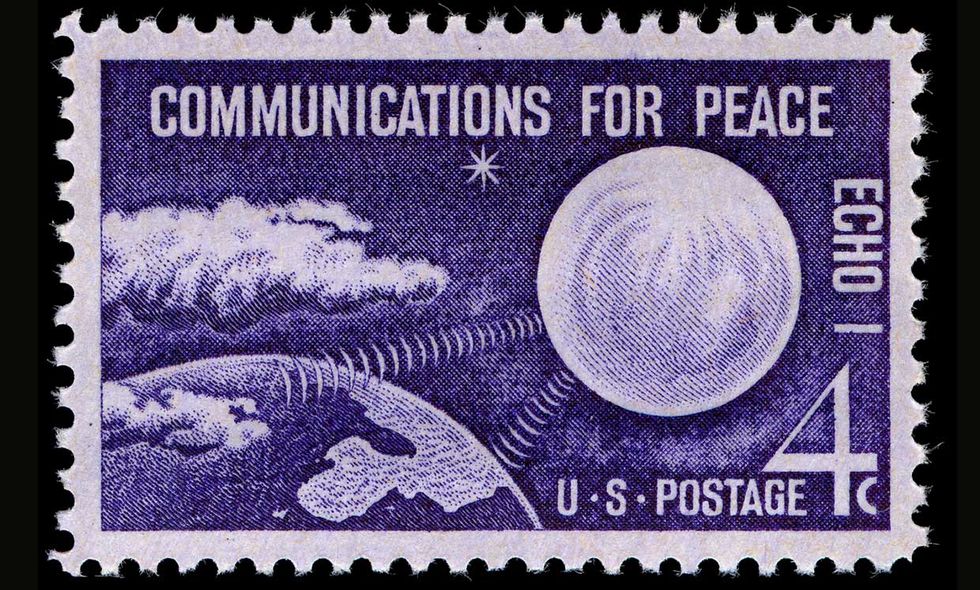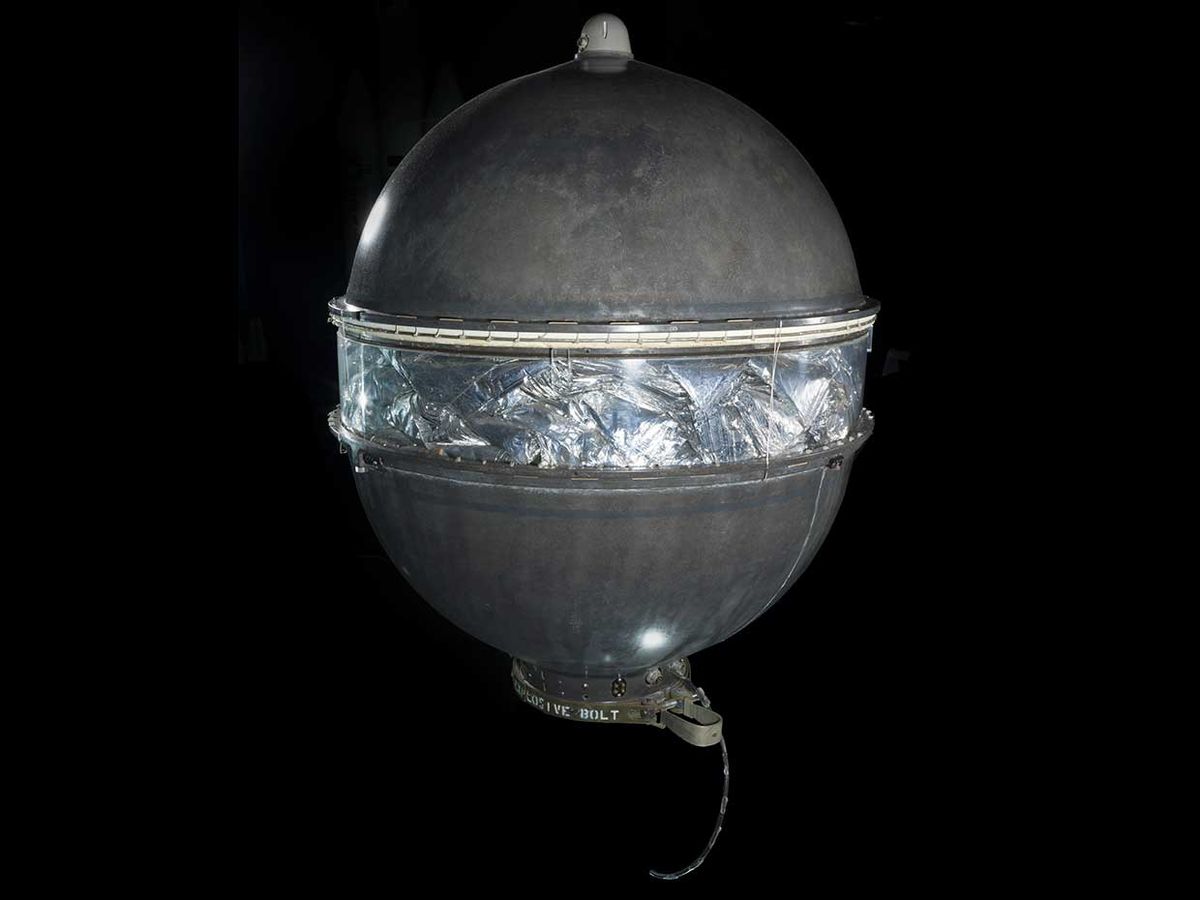During the past few months, complaints have been mounting about delays and out-of-date equipment at the U.S. Postal Service. Such complaints were also familiar to Arthur Summerfield, who served as U.S. Postmaster General from 1953 to 1961. Summerfield had inherited a system that was still largely processing the mail by hand, and he set out to automate and mechanize the work. But he also had big dreams of the next frontier in mail: space.
How do you deliver mail by satellite?
In 1960 Summerfield partnered with NASA to use the space agency’s Echo 1 satellite for Speed Mail, a service that would allow customers to send letters rapidly across the country. Echo 1 was an early experiment in satellite communication. Launched inside a metal sphere [a spare of which is shown above], it inflated in low Earth orbit into a giant Mylar balloon, 100 feet (30.5 meters) across. Project personnel dubbed it a “satelloon.” It circled the globe every 2 hours, reflecting radio, telephone, and TV signals on two channels—960 megahertz and 2390 megahertz—between ground stations.
How did Speed Mail work? Patrons would compose their Speed Mail missives on special stationery, similar to the Victory Mail forms used to expedite letters to U.S. soldiers during World War II. The sender would take the Speed Mail form to a designated post office. In accordance with privacy laws and expectations, postal employees would never see the contents of the sealed letter. Instead, a special machine would automatically open the letter, scan it, and then beam the contents via Echo 1 to the destination post office, where it would be printed, sealed, and delivered.
On 9 November 1960, the postmaster sent the first Speed Mail letter. Addressed to “Mr. and Mrs. America,” the letter urged people to post their holiday cards and presents early. That remains sound advice even in the Internet age and certainly during a global pandemic.
Summerfield’s message originated at a postal substation in the Federal Center Building in Washington, D.C., from which it was sent by telephoto circuit—what we would call a fax machine—to the Naval Research Laboratory at Stump Neck, Md. From there it was transmitted to Echo, which dutifully reflected the contents back down to Earth. The Bell Telephone Laboratories station in Holmdel, N.J., picked up the signal and converted it back into a telephoto message. It then traveled over phone lines to nearby Newark, and a facsimile receiver reprinted the original message. Quite a journey for a single letter.

Summerfield envisioned a network of 71 Speed Mail stations set up in post offices throughout the United States. He said that each Speed Mail machine would be able to handle up to 15 letters per hour, simultaneously sending and receiving messages. He expected Speed Mail to become popular with the public, estimating that three quarters of the volume would be civilian mail, with communications among defense agencies making up the rest.
Speed Mail was not Summerfield’s first foray into experimental delivery methods. A year earlier, he had launched Missile Mail, with a payload of 3,000 letters tucked inside a Regulus I missile. Shortly before noon on 8 June 1959, the U.S.S. Barbero fired the missile from international waters in the Atlantic Ocean. Twenty-two minutes later, the missile successfully landed at Mayfield Naval Base in Jacksonville, Fla.
“This peacetime employment of a guided missile for the important and practical purpose of carrying mail, is the first known official use of missiles by any Post Office Department of any nation,” announced an enthusiastic Summerfield. He speculated that “before man reaches the moon, mail will be delivered within hours from New York to California, to Britain, to India or Australia by guided missiles.”
Of course that didn’t happen. Missile Mail was a one-hit wonder. Similarly, Congress never approved funding to expand Speed Mail beyond the initial tests. In January 1961, newly inaugurated President John F. Kennedy appointed J. Edward Day as Postmaster General to replace Summerfield. Day’s approach to mail processing was far more down-to-earth. Americans can thank him for introducing 5-digit postal codes, known as Zone Improvement Plan, or ZIP, codes, that sorted the mail into geographic regions.
Project Echo’s rich legacy: satellite spotting, the big bang, and trippy public art
Meanwhile, Echo 1 continued in its orbit for much longer than its expected 1-year life span and helped collect a wealth of information about Earth’s atmosphere. The satelloon didn’t have any fancy instrumentation. It carried only temperature and pressure gauges, plus two 107.9-MHz transmitting beacons powered by 70 solar cells and five batteries that scientists could use to track the satellite. Solar pressure would gradually nudge Echo off orbit, and scientists measured the change to quantify the effect. They also used it for triangulation, to create more accurate maps. Perhaps most important, Echo proved that the ionosphere didn’t cause undue electrical interference for signals reflected from space.
Echo 1’s passage over the Goldstone Tracking Station is visible as a long streak in this 12 August 1960 photo.Photo: JPL-Caltech/NASA
Project Echo was a joint collaboration of NASA, the Jet Propulsion Lab in Pasadena, Calif., and the U.S. Naval Research Laboratory in Washington, D.C. Bell Labs developed the instruments to transmit and receive the signals. In the Mojave Desert, at JPL’s Goldstone Tracking Station, the signal passed through a pair of 85-foot (26-meter) parabolic dishes. On the other side of the country, in Holmdel, N.J., a Bell Labs transmitter and a steerable, 15-meter-long “horn” receiver picked up the reflected signals. The horn was plagued by faint static, so radio astronomers Arno Penzias and Robert Wilson spent significant effort investigating the cause, eventually concluding in 1965 that it was detecting microwave radiation left over from the creation of the universe. For this confirmation of the big bang, Penzias and Wilson shared the Nobel Prize in Physics in 1978.
In 1964, NASA launched Echo 1’s slightly larger successor, Echo 2, into a near-polar orbit. Both satellites were easily visible from the ground without the aid of binoculars or telescopes. Echo-watching became a popular pastime, with newspapers publishing timetables of when the satellites would pass overhead. Echo 1’s orbit eventually decayed, and the satellite burned up in the atmosphere on 24 May 1968. Echo 2 followed a year later, ending its mission on 7 June 1969.
Meanwhile, the company that manufactured the Mylar balloons, G.T. Schjeldahl Co., went on to create a trippy spherical mirror for the 1970 World’s Fair. [See “When Artists, Engineers, and PepsiCo Collaborated, Then Clashed at the 1970 World’s Fair.”]
At the beginning, Project Echo was something out of science fiction— literally, it was described in an essay by J.J. Coupling titled “Don’t Write: Telegraph!” in the March 1952 issue of Astounding Science Fiction, in which the author envisioned a world enriched by interplanetary communication. “J.J. Coupling” was the pseudonym of John R. Pierce, Bell Labs’ director of electronics research, and in his day job he worked to make that world a reality. Echo proved the feasibility of commercial satellite communications, but it was just the beginning. Eventually, active communications satellites that could amplify and rebroadcast messages proved more useful than passive satelloons that simply reflected an echo.
An abridged version of this article appears in the December 2020 print issue as “Special Delivery by Satellite.”
Part of a continuing series looking at photographs of historical artifacts that embrace the boundless potential of technology.
About the Author
Allison Marsh is an associate professor of history at the University of South Carolina and codirector of the university’s Ann Johnson Institute for Science, Technology & Society.
Allison Marsh is a professor in Women and Gender Studies at the University of South Carolina and codirector of the university’s Ann Johnson Institute for Science, Technology & Society. She combines her interests in engineering, history, and museum objects to write the Past Forward column, which tells the story of technology through historical artifacts. Marsh is currently working on a book on the history of women in electrical engineering.



